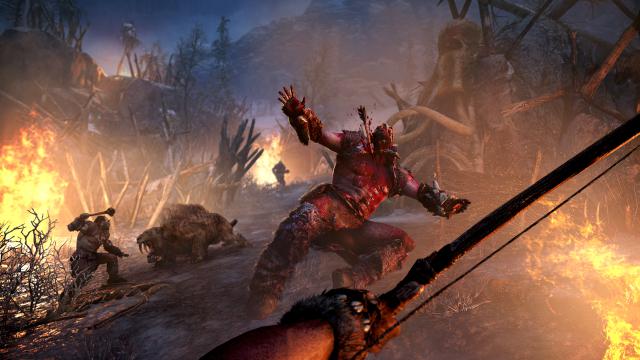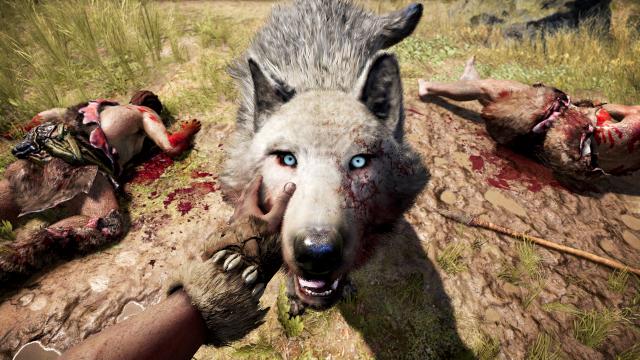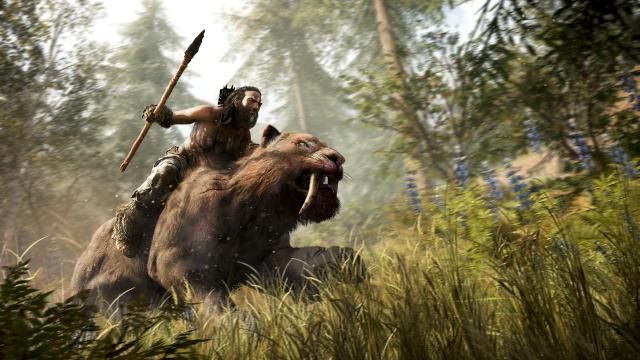
What do you do when every shooter on the market is trying to outdo every other by bringing bigger guns, louder explosions and more heavily armoured enemies than we’ve seen before? How do you continue to make your upcoming games challenging without carrying on with the bizarre one-upmanship which has started to creep into certain series of games? Well, if you’re Ubisoft you come up with the perfect answer: take away the guns, take away the explosions, and push you back to 12,000 years ago where survival is every bit as tricky as you’d expect.
Far Cry Primal follows the same kind of formula you’ll have seen in other recent Far Cry titles – a massive open world, natural resources to track down and use to improve weapons and medicines and more missions than you can shake a spear at. But gone are the machine guns, grenades and jeeps, replaced instead by clubs, bow and arrows and bags of bees to fling at your enemies. This lack of firepower sounds restrictive and unfair, but let’s not forget that your enemies only have the same tools at their disposal as well, and while it might be tougher to dispose of groups of enemies it’s also tougher for them to take you out as well. Well, that’s how the theory goes anyway.

What gets in the way a little is something which has been ramped up since Far Cry 4: the wildlife. While it wasn’t uncommon to get attacked by an animal while out and about before, this time you’ve got far more to worry about. Jaguars, lions, bears, even mammoths and badgers will come at you with incredible force. Yes, badgers. Nasty little buggers they are. Some of these can be stopped in their tracks with a finely aimed arrow to the head, but the more powerful creatures won’t even let that put them off. Think you can put a bear off with something as simple as skewering their melon with a flaming arrow? Think again.
What redresses the balance a bit is the ability to tame most of these creatures by side-tracking them with a lump of meat and doing some cool pre-historic Dr Dolittle trick to get them onside. You can have any one of the beasts you’ve tamed accompanying you at any one point, and even change them whenever you choose or send them away completely (which is more useful than it sounds when they start scaring off a creature you’re trying to tame). Choosing your creature carefully can make a huge difference to how well your current mission goes, and studying the relevant perks which each animal grants you is well worth a few moments of your time. You don’t, for example, want an animal with no stamina when you’re charging into a group of 15 bad guys all armed with flaming spears and spiked clubs, but at the same time you won’t want to be riding a mammoth to try and quietly take out someone standing guard at a campsite.

While you’re doing all this there’s a storyline ticking along underneath, which is handy but not as pronounced as the plots in other recent Far Cry games. You’re playing as Takkar, braving the lethal world of Oros to rescue your fellow Wenja and get them all safe in a camp on the Western edge of the region. You can upgrade various aspects of your camp, and as you find and rescue certain key figures in the Wenja community (including a guy with one arm who chooses to call you “piss-man” for the rest of the game for reasons which are clear after you encounter him) building and upgrading their huts will afford you new weapons, upgrades and more routes through your ability tree. And it’s often a tricky decision to make: do you unlock the ability for your owl to drop bundles of angry bees on enemies, learn to tame sabre-toothed tigers or heal yourself while running away? They’re decisions you’ll be familiar with to a degree if you’ve been a fan of the other games in the series, but the cut-throat nature of your surroundings mean that every last choice is vital and could make a huge difference in your survival chances.
After a significant chunk of time you’ll rock up to tackle Ull – the head Udam who you’ve been working up to having a pop at for most of the game. Along the way you’ll have slain huge numbers of animals, as well as Udam and Izila enemies who form the two other tribes in Oros who don’t take too kindly to you rocking up on their patch. You’ll have far more powerful weapons, your survival will be increased, and you’ll have made friends with some seriously badass creatures as well. It’s still a tough closing couple of hours, but as long as you don’t rush through you should be well enough equipped with most of what you need. And it’s not as if you can send in some grenades, blast a few huts with a flame thrower and pick enemies off with a sniper rifle from a safe distance; in Primal you’ll need to really think about how you’re about to approach a big fight, and that’s something which makes the game far more than it might’ve been otherwise.

So by taking a leap into the unknown Ubisoft could’ve tripped over their own feet and ended up with a long, slow and uninspired title. But that’s not what’s happened. Instead Far Cry Primal is one of my favourite Far Cry games so far, and while it doesn’t have the explosive settings and set-pieces of Far Cry 4 the total change of pace and approach is something so incredibly refreshing and novel that you can’t help but spend hours just wandering the unspoilt lands of Oros, claiming campfires, clearing out enemy camps and hunting those gorgeous but incredibly violent jaguars just so you can tart up on of the village huts with their skins. It’s a real breath of fresh air, and one which could reinvigorate the Far Cry series for another few games.
Well played Ubisoft on taking a risk – it’s provided us gamers with a great reward.
Reviewed on PS4


Leave a Reply